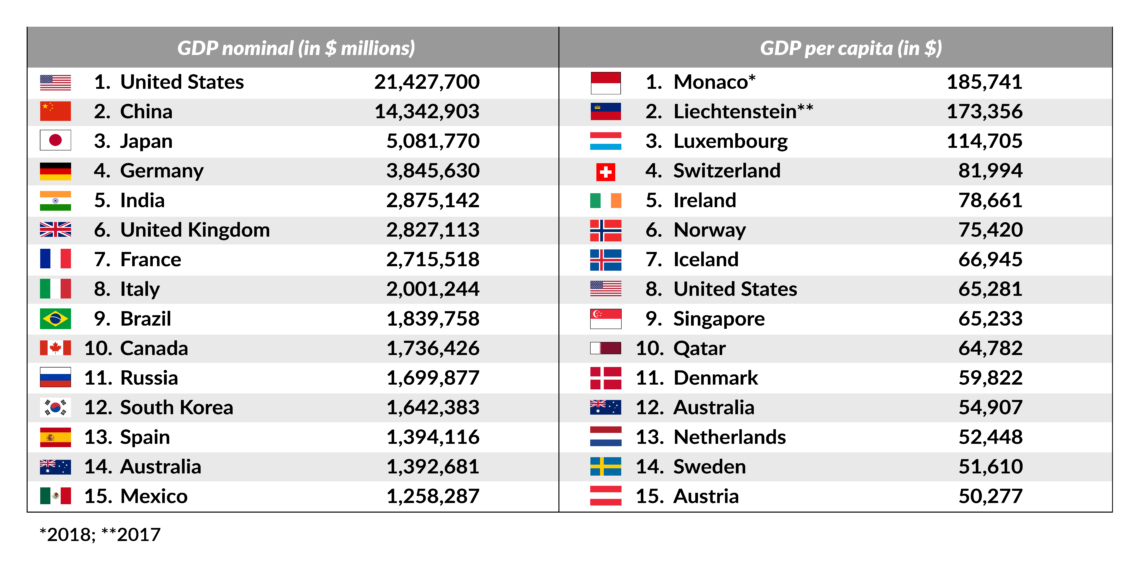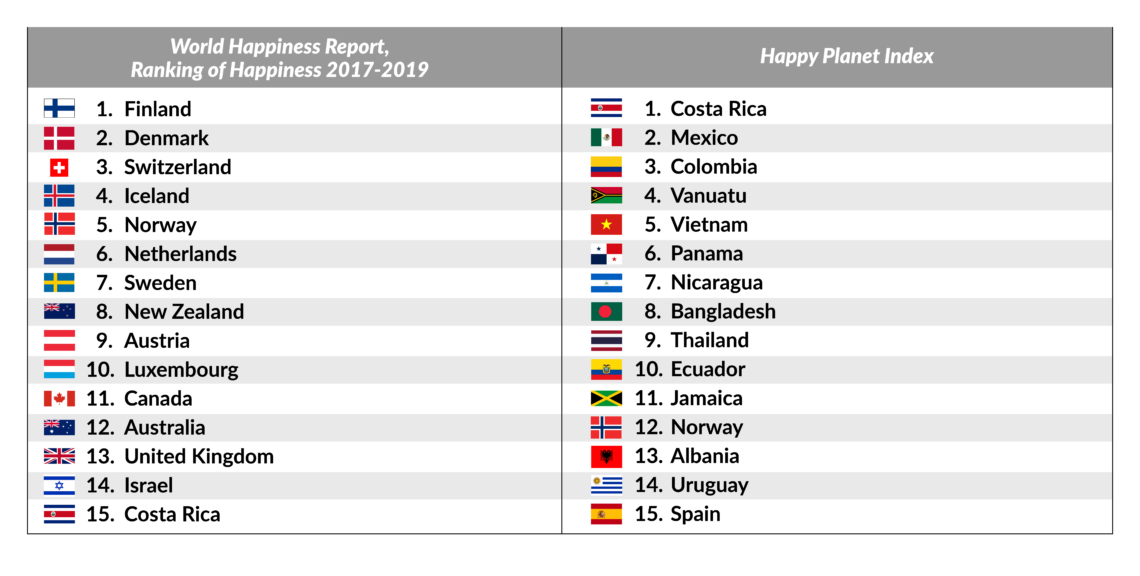Measuring prosperity: The quest to replace GDP
For years, gross domestic product (GDP) has been the dominant metric for measuring a country’s prosperity. Recently, however, it has come under criticism for not including factors such as equality or environmental sustainability. Replacing it will be a tricky task.

In a nutshell
- GDP is an imperfect way of measuring prosperity
- Alternative methods can be methodologically flimsy
- Politicians will still use other metrics if they think they can benefit
Since the Covid-19 crisis hit, many intellectuals have called for a “Great Reset.” They stress not only that there needs to be a change in the capitalist mindset toward more sustainability and social inclusion, but also a shift in how we measure prosperity, away from gross domestic product (GDP), which they believe is too materialistic a metric.
The sentiment is not new. In 2008, French President Nicolas Sarkozy tasked a group of economists, led by Nobel laureate Joseph Stiglitz, to provide suggestions for improving the measurement of economic performance and social progress, without relying on GDP. Their final report called for better measures and more accurate information but offered no replacement.
GDP’s cousin, gross national product (GNP), was crafted by economist and statistician Simon Kuznets in the 1930s. It measures national income based on the output of nationals (GDP measures the output of residents) over a period of time, usually a year or a quarter. GNP and GDP add together the value of final goods. A simple division by the population gives GNP or GDP per capita.
GDP has become the standard yardstick for assessing countries’ economic growth.
GDP has now become the standard yardstick for assessing and comparing countries’ level of economic growth and, to some extent, prosperity – although it is a flow, not a stock (see box). Today the level and trajectory of a country’s GDP play a crucial role in determining the interest rates it will pay on its sovereign bonds, among other things. In the eurozone, the Growth and Stability Pact requires member countries to meet deficit and public debt targets, measured in proportion to GDP.
Facts & figures
Stock vs. flow
In economics, stocks and flows are two types of quantities. A stock measures the accumulated value of a given amount at a specific point in time (like “wealth”). A flow is the additional amount measured over an interval of time, like a quarter or a year. GDP is measured this way and is therefore a flow.
Gross limitations
GNP and its successor GDP have various shortcomings. Mr. Kuznets was well aware of these. He warned that such indicators were a good measure of productivity, but not welfare. Moreover, they can give us good insight into traditional, “wheat-and-steel” economies but less so for more modern, innovation-driven ones. More broadly, GDP cannot measure what is not paid for: things like using Google Maps or Wikipedia for free (a potential explanation for the “secular stagnation” in our digitized world) as well as doing volunteer work or pruning one’s own hedges. These activities create value but are not counted in GDP. Negative external factors, like pollution, are not included either. GDP is bad at measuring environmental sustainability and even tallies some things that clearly harm welfare – such as natural disasters – as positives when they increase spending.
When economic sectors grow, especially quickly, it reflects positively in GDP, even if it is the result of policies or regulations that have inflated their profits and generated troubling imbalances. An example of this was the massive growth of the housing and financial sectors in the United States in the early 2000s.
Facts & figures

This kind of policy-induced sector growth usually hides malinvestment that ends up in a correction or even a recession. Moreover, if a country’s GDP is pulled up by the increasing prices of its natural resources, then no effort or real production – and some would say no genuine economic development – was behind it. The same goes for regions that benefit from aid money. The growth of some redundant parts of the public sector can also be counted as a positive in GDP calculations.
One of the biggest gripes about GNP and GDP per capita is that they do not reflect inequality in a society. Since they are just averaged aggregates, they do not say anything about the distribution of income. High GDP per capita can actually hide extreme income polarization – a tiny part of society may be pocketing most of the GDP, while the majority languish in poverty. Besides, affluence does not necessarily mean more happiness, longer, healthier lives or social cohesion. Given all these limitations, various attempts have emerged since the 1960s to improve on GDP.
The great puzzle
Doing so, however, is no easy task, which is why GDP has dominated indicators of economic health since its inception. There are several factors to consider. First, GDP’s simplicity is not only its weakness, but also its strength. Trying to compute a composite index, often based on subjective evaluations for various items, invites complexity and uncertainty. Some authors prefer to add accounts that supplement GDP, rather than replace it.
Second, there are a host of different dimensions that can be added into the measurement of well-being, from happiness to environmental sustainability, health, life expectancy, financial sustainability, inequality, “real” production, social capital or inclusiveness. Which should be included, and how should the new metrics be weighted?
Happiness does not automatically follow from economic development.
Another aspect is the unclear distinction between outcomes and conditions, and what that means for welfare. For example, is freedom a condition or outcome of development? Finally, the impracticality of data-gathering of some indicators can limit the measurement to a handful of countries, preventing international comparisons.
Happy alternatives
While we should not idealize preindustrial times when it comes to human well-being and freedom, happiness does not automatically follow from economic development. GDP increases can indicate a growing economy that lifts some out of poverty and thereby increases happiness, but a saturation point is soon reached as the excessive accumulation of goods that usually comes with higher GDP levels can be a source of distraction and frustration. Higher GDP rates often indicate a deterioration of the natural environment.
In 1972 then-King Jigme Singye Wangchuck of Bhutan launched the use of Gross National Happiness, an index that reflects the Buddhist traditions of his country and includes more than just living standards. While the strength of the measure is probably its breadth (with added components ranging from health to the environment, psychology and culture), it also requires a survey of several dozen questions. The number of surveyed households is necessarily small and the nature of the answers subjective, which opens it up to criticism over methodology.
Other happiness measures followed with more and more items but the same methodological limitations, such as the World Happiness Report and the Happy Planet Index. Some indicators focus more on environmental sustainability, like Green GDP, which includes environmental setbacks such as loss of biodiversity. The Organisation for Economic Co-operation and Development (OECD) also computes Green Growth Indicators. The United Nations has the Sustainable Development Goals Index.
Some researchers have insisted on a measure of wealth as a stock (rather than a flow). For example, National Wealth Accounting complements GDP by showing the stock of produced, as well as natural and human capital to better assess the sustainability of development.
More inclusiveness
The most well-known alternative measurement to GDP is probably the Human Development Index, created in the 1990s by the UN. It adds education and life expectancy to income per capita, in an effort to reflect opportunity. In 2010 it was adjusted to include inequality.
However, some argue that other dimensions are needed to measure inclusiveness. In 2007 the Legatum Institute in London launched its Prosperity Index to incorporate various aspects of social welfare. It is based on economic performance, entrepreneurship, education, democratic governance, health, personal freedom, safety and social capital. Some of these measures are also included in the Better Life Index introduced in 2014 by the OECD. The World Economic Forum’s Inclusive Development Index, launched in 2017, also uses measures of inclusiveness, sustainability and equality.
Economic conditions
Institutional economic conditions also play a role in improving well-being. In this respect, measurements like the World Bank’s Doing Business ranking (which computes how easy to do business in a country) or the various indexes of economic freedom are crucial to understanding the underpinnings of prosperity. Such states require economic growth based on entrepreneurial effort that, in turn, requires a favorable incentive structure.
GDP focuses on the value of final goods and only looks at the demand side.
In some senses, GDP is not materialistic enough. It focuses on the value of final goods, leaving out the intermediate stages of production, and looks essentially at the demand side. Free-market economists such as Mark Skousen or Steve Hanke insist we should be measuring the whole value process of production. This can be done with measures like Gross Output or Gross Domestic Expenditure.
Using these not only reduces the weight of consumption and government spending, but also gives us a better grasp of the real growth of the supply side of the economy and a much sharper view of the business cycle. The immediate conclusion from such measures is that entrepreneurship is the ultimate source of economic prosperity, a crucial part of well-being in the broader sense.
Supporters of such indicators usually also favor government accountability and fiscal sustainability. The use of an “index of fiscal illusion” to assess how transparent and accountable a government is regarding its spending could help improve long-term financial sustainability. Academics have tried to create such an index, but the results have gained little traction. In any case, ratings agencies and investors regularly assess countries’ financial sustainability.
Scenarios
Which index will win out? There are two broad potential scenarios.
One is that King GDP will not be dethroned. Its role as a cornerstone metric in various official calculations will solidify its position for the foreseeable future. Competition among the other metrics makes it more difficult for any of them to gain a foothold. The ability to use complementary measures (such as the Gini coefficient for inequality) to refine GDP strengthens its claim. In this scenario, GDP will dominate for a while, though possibly with improvements like adding the complements mentioned above.
Another perspective sees GDP losing ground due to political agendas in various countries. When those in power see that different metrics can bolster their political philosophies, they may begin to cast GDP aside. The other measures will gain ground, regardless of how methodologically questionable they may be. The recently popular measure of “carbon footprint” is a good example. Energy sources that emit less carbon dioxide (such as diesel, nuclear power or electric batteries) can produce significant pollutants or other dangers.
Political actors can resort to conveying a false impression of environmental friendliness or social benefits (known respectively as “greenwashing” and “social washing”) to gain economic or geopolitical leverage. Bureaucracies have a vested interest in promoting their own favored measure of welfare, since its adoption would likely increase their power to regulate and receive funding.
The Covid-19 crisis could favor either scenario, depending on the country. Those that experience a strong economic recovery will be happy to stick with GDP as their measure of choice. In those with moribund economies, politicians may want to find new performance metrics, such as environmental sustainability or inequality, to distract attention from their economic failures. Whichever of these two groups outweighs the other will tip the balance for or against GDP. Perhaps the “Great Reset” narrative will also reset how we measure our well-being.








